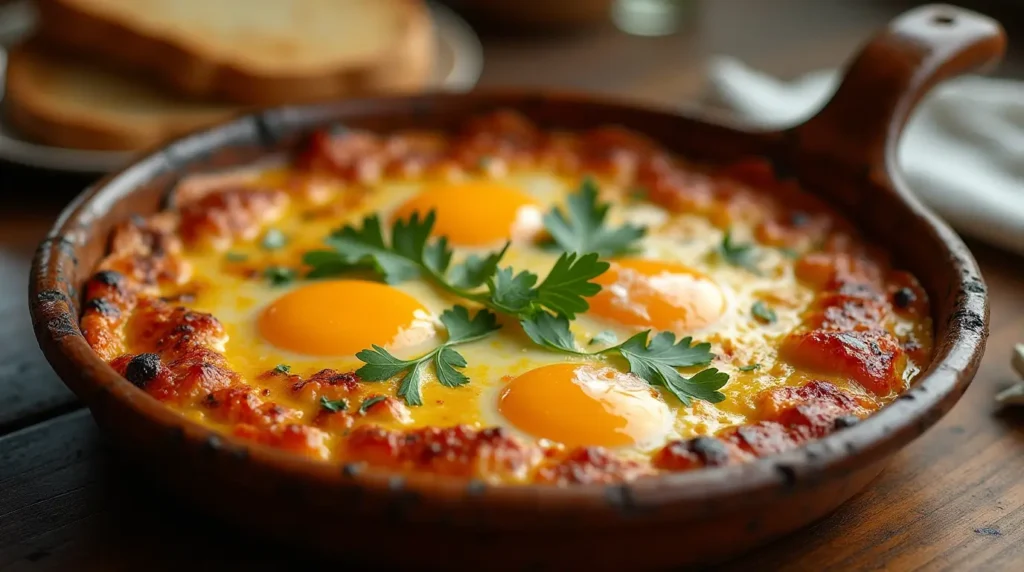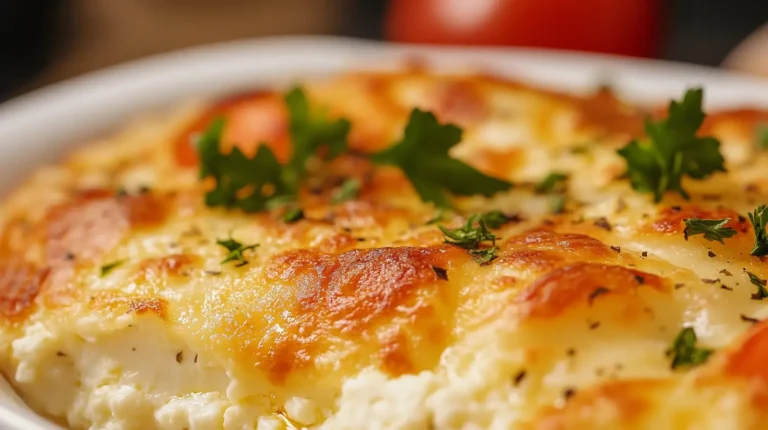Baked Egg Challenge Recipe: 5 Steps to Make It Perfectly
Baked Egg Challenge Recipe made easy! Learn the simple steps and ingredients to create this delicious breakfast dish in no time.

Table of Contents
What Is the Baked Egg Challenge Recipe?
The Baked Egg Challenge Recipe is both a culinary dish and a process used to test egg allergy tolerance. For individuals with egg allergies, this challenge involves consuming small portions of fully baked foods containing eggs, such as muffins or cakes, in a controlled setting.
Why Is This Challenge Important?
- Assesses Egg Tolerance Levels: Helps individuals and doctors gauge how much egg protein is tolerable in baked form.
- Supports Gradual Desensitization: Controlled exposure to baked eggs may reduce allergic sensitivity over time.
- Promotes Dietary Diversity: Once baked eggs are tolerated, it opens the door to a wider range of food options.
For example, you can explore variations like Baked Cottage Cheese Eggs, a creative way to incorporate baked eggs into a diet safely.
Benefits of the Baked Egg Challenge Recipe
- Gradual Allergy Desensitization
Controlled exposure to baked eggs may help the immune system adapt to egg proteins. Over time, many individuals, especially children, show increased tolerance with regular exposure. - Expanded Food Options
Once baked eggs are tolerated, you can safely enjoy a variety of baked goods, including cookies, cakes, and muffins. Recipes like Crescent Roll Breakfast Ideas can easily be tailored to suit dietary needs. - Potential Long-Term Allergy Improvement
Studies have shown that children who tolerate baked eggs are more likely to completely outgrow their egg allergy, leading to greater dietary freedom.
Safety Considerations Before Trying the Baked Egg Challenge Recipe
- Check for Allergies:
Ensure that the individual attempting the recipe does not have severe allergies or intolerances to eggs, dairy, or other ingredients. If needed, use substitutes like dairy-free cream or cheese. - Use Fresh Ingredients:
Opt for fresh eggs, cream, and cheese to maintain quality and avoid foodborne illnesses. Always verify expiration dates and inspect ingredients for signs of spoilage. - Wash Your Hands Thoroughly:
Properly wash your hands and utensils before and after handling raw eggs to prevent contamination. - Cook at the Correct Temperature:
Preheat the oven to 375°F (190°C) and bake until the egg whites are fully set. This ensures the eggs are safe to consume. - Use an Oven-Safe Dish:
Choose a heat-resistant dish or skillet to avoid accidents. Non-stick and well-greased dishes make cleanup easier. - Handle Hot Equipment Carefully:
Use oven mittens when removing the dish from the oven to prevent burns. Allow the dish to cool slightly before serving. - Avoid Cross-Contamination:
After cracking eggs, clean all surfaces, bowls, and tools to eliminate the risk of bacterial contamination. - Cook Toppings Separately:
If adding meats like sausage or bacon, ensure they are fully cooked before incorporating them into the dish. - Bake with Precision:
Keep a close watch on the eggs while they bake. Overcooking may result in tough eggs, while undercooking can leave them unsafe to eat. - Serve Immediately:
Serve the baked egg dish hot to enjoy its best flavor and texture. Avoid letting it sit out for too long.
Step-by-Step Baked Egg Challenge Recipe
Ingredients:
- 6 large eggs
- 1 cup of your favorite shredded cheese (cheddar, mozzarella, or a combination)
- 1/2 cup heavy cream
- 1/4 cup grated Parmesan cheese
- 1 tbsp olive oil or butter for greasing
- 1/2 tsp garlic powder
- Salt and pepper to taste
- Fresh parsley or chives for garnish
- Optional: Diced tomatoes, cooked bacon, sautéed spinach, or other toppings
Instructions:
- Preheat the Oven:
Set the oven to 375°F (190°C). - Prepare the Dish:
Grease an ovenproof skillet or baking dish with olive oil or butter to prevent sticking. - Layer the Cheese:
Spread the shredded cheese evenly on the bottom of the dish. - Make the Cream Mixture:
In a small bowl, whisk together heavy cream, Parmesan cheese, garlic powder, salt, and pepper. Pour this mixture evenly over the shredded cheese. - Add the Eggs:
Gently crack the eggs over the cream and cheese mixture, spacing them apart evenly. - Bake:
Place the dish in the oven and bake for 12–15 minutes, or until the egg whites are set and the yolks are cooked to your liking. If you prefer firmer yolks, bake a little longer. - Garnish and Serve:
Remove the dish from the oven and sprinkle freshly chopped parsley or chives on top. Serve hot alongside crusty bread or a fresh side salad for a complete meal.
The Baked Egg Challenge Recipe is not only a delicious dish but also a potentially life-changing step for those with egg allergies. It provides a safe way to reintroduce eggs into the diet while offering a healthy, protein-packed meal option. If you’re looking for other fun breakfast recipes, consider trying Cake Mix Cinnamon Rolls or Egg Muffins for variety.
Enjoy the process, and always prioritize safety when attempting any food-related challenges! Challenge Recipe?
The baked egg challenge is a food allergy test where individuals with egg allergies consume a small portion of a fully baked food item containing eggs, typically muffins or cakes.
Why Is This Challenge Important?
- Helps assess egg tolerance levels.
- Allows gradual desensitization to egg proteins.
- This may contribute to outgrowing egg allergies sooner.
Introducing baked eggs carefully into a diet can be an important step toward greater food variety. Another good option to try is Baked Cottage Cheese Eggs, which offers a different way of consuming baked eggs safely.
For those already incorporating eggs into meals, dishes like shrimp-and-rice may be an exciting option once tolerance improves.
Benefits of the Baked Egg Challenge Recipe
1. Gradual Allergy Desensitization
- Controlled exposure to baked eggs can help train the immune system to tolerate egg proteins.
- Many children with egg allergies show increased tolerance over time with regular exposure.
2. Expanded Food Choices
- Once baked eggs are tolerated, individuals can safely consume a wider range of baked goods, such as cakes, muffins, and cookies.
- You might enjoy Crescent Roll Breakfast Recipes, which include various baked goods that can be adapted to dietary needs.
3. Possible Long-Term Allergy Reduction
- Studies suggest that children who tolerate baked eggs are more likely to outgrow their egg allergy completely.
Safety Considerations Before Trying the Baked Egg Recipe
- Check for Allergies:
Ensure you and anyone you’re serving the dish to do not have allergies to eggs, dairy, or any other ingredients in the recipe. Substitute ingredients if necessary (e.g., dairy-free cheese or cream). - Use Fresh Ingredients:
Always use fresh eggs, cheese, and cream to prevent foodborne illnesses. Check expiration dates and inspect the ingredients for freshness before starting. - Wash Your Hands:
Wash your hands thoroughly before handling eggs to avoid cross-contamination. Raw eggs can carry bacteria like salmonella, so proper hygiene is essential. - Cook at the Right Temperature:
Preheat the oven as instructed (375°F or 190°C) and bake the eggs until the whites are fully set. Avoid undercooking to reduce the risk of consuming harmful bacteria. - Use an Oven-Safe Dish:
Ensure the baking dish or skillet you’re using is oven-safe to prevent accidents or damage. Avoid glass dishes that may shatter at high temperatures. - Handle Hot Equipment Safely:
Always use oven mittens when placing or removing the dish from the oven. Let the dish cool for a minute before serving to avoid burns. - Clean Surfaces Thoroughly:
After cracking eggs, disinfect all surfaces, utensils, and your hands to eliminate any traces of raw egg that could spread bacteria. - Be Careful with Add-Ons:
If you’re adding meat (like bacon or sausage), ensure it is fully cooked before incorporating it into the recipe to avoid undercooked proteins. - Monitor Cooking Time:
Keep a close eye on the eggs as they bake. Overbaking can result in rubbery eggs, while underbaking may leave the yolks too runny for safety. - Serve Immediately:
Serve the baked eggs right after cooking to enjoy them at their best quality and to prevent them from sitting at unsafe temperatures.
By following these safety tips, you can enjoy the Baked Egg Challenge Recipe safely and deliciously!
If you are exploring new ways to incorporate baked eggs into your diet, Cake Mix Cinnamon Rolls could be a fun and easy option to try.
Step-by-Step Baked Egg Challenge Recipe
Ingredients
- 6 large eggs
- 1 cup shredded cheese (cheddar, mozzarella, or a mix)
- 1/2 cup heavy cream
- 1/4 cup grated Parmesan cheese
- 1 tbsp olive oil or butter
- 1/2 tsp garlic powder
- Salt and pepper to taste
- Fresh parsley or chives (chopped, for garnish)
- Optional toppings: Diced tomatoes, cooked bacon or sausage, or sautéed spinach.
Instructions:
- Preheat the oven to 375°F (190°C).
- Prepare the dish: Grease a baking dish or ovenproof skillet with olive oil or butter.
- Layer cheese: Spread the shredded cheese evenly across the bottom of the dish.
- Add cream mixture: In a bowl, mix heavy cream, Parmesan cheese, garlic powder, salt, and pepper. Pour this mixture over the shredded cheese.
- Add eggs: Carefully crack the eggs onto the cheese and cream layer, spacing them out evenly.
- Bake: Place the dish in the oven and bake for 12–15 minutes, or until the egg whites are set but the yolks are still slightly runny. (Bake longer if you prefer firmer yolks.)
- Garnish and serve: Remove from the oven and sprinkle with fresh parsley or chives. Serve hot with crusty bread or a side salad.
- Enjoy this easy and delicious baked egg dish!
For another unique and nutritious egg-based dish, check out Cooked Cabbage with Eggs, which is a great option for breakfast or dinner.
Steps to Follow:
Looking for another breakfast option? Egg Muffins Recipe is a great alternative.

(FAQs) For the Baked Egg Challenge Recipe
1. What is the Baked Egg Challenge?
The Baked Egg Challenge Recipe is a simple, flavorful dish made by baking eggs with cheese, cream, and optional toppings. It’s perfect for breakfast, brunch, or a light dinner.
2. What ingredients do I need for this recipe?
You’ll need eggs, shredded cheese, heavy cream, Parmesan cheese, salt, pepper, and optional herbs like parsley or chives. You can also add toppings like bacon, tomatoes, or spinach.
3. Can I customize the recipe?
Yes! You can customize the Baked Egg Challenge Recipe by adding your favorite ingredients, such as vegetables, cooked sausage, or different types of cheese.
4. How long does it take to prepare and bake?
Preparation takes about 5–10 minutes, and baking typically takes 12–15 minutes, depending on how firm you like your egg yolks.
5. Can I make this recipe ahead of time?
While it’s best enjoyed fresh, you can prepare the ingredients ahead and bake when ready to serve. Reheating baked eggs may alter their texture slightly.
6. What type of dish should I use for baking?
Use an oven-safe skillet, baking dish, or casserole dish for the recipe. Ensure it’s greased with butter or oil to prevent sticking.
7. How can I tell if the eggs are done?
The egg whites should be set, and the yolks should still be slightly runny (or cooked to your preference). Keep an eye on them as they bake.
8. Can I make this recipe dairy-free?
Yes! Substitute the cream and cheese with dairy-free alternatives like coconut cream and vegan cheese.
9. What can I serve with this dish?
Serve baked eggs with crusty bread, toast, a side salad, or fresh fruit for a complete meal.
10. Is this recipe kid-friendly?
Absolutely! Kids love the cheesy, creamy texture of baked eggs. You can even let them pick their favorite toppings.
Final Thoughts
The Baked Egg Challenge Recipe is a versatile and delicious dish that’s perfect for breakfast, brunch, or even a light dinner. With its simple preparation and rich flavors, it’s an ideal choice for beginners and seasoned cooks alike. Whether you’re looking to impress guests or enjoy a cozy meal at home, this recipe delivers every time. Experiment with different toppings and seasonings to make it your own. Give it a try, and savor the magic of baked eggs!
As you expand your dietary options, you might enjoy trying Chocolate Brioche, a delicious baked treat that can fit into an allergy-friendly diet if tolerated.
If you’re considering the baked egg challenge, always consult with a qualified allergist to ensure it’s safe for you or your child.







